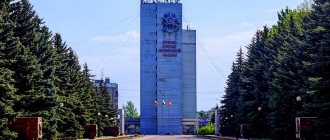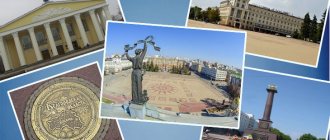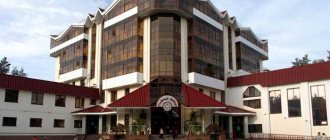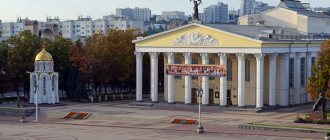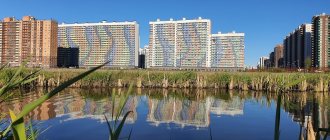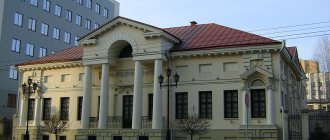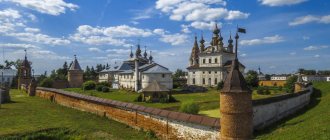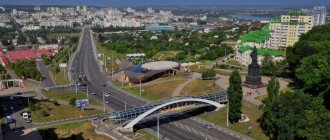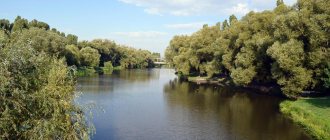Tourism
- Kholkovsky Cave Monastery
- Sights of the village Shopino
- Barkov's Mill
- Krapivinskoe settlement
- Palace complex in the village of Rakitnoye
The most important attraction of the Belgorod region is the diorama “Battle of Kursk”. The museum is visited by tourists who come to Belgorod for 1-3 days . There are many ancient Orthodox churches on Belgorod land. Rural tourism is developed in the region.
History of Belgorod.
There are discussions among historians about the exact time of the emergence of the city of Belgorod. Some believe that in ancient times there stood the Seversky settlement, founded in the 10th century by order of Prince Vladimir and which served to protect the borders of Rus' from nomadic peoples. Therefore, in 1995, the 1000th anniversary of the White City was solemnly celebrated. But most archaeological finds confirm another hypothesis, according to which Belgorod arose much later - in 1596, when the fortress was built. This means that the city is a little over 400 years old.
With the loss of its significance as a defensive structure, Belgorod turned into a county town. After a big fire occurred in the 18th century, it had to be rebuilt. St. Petersburg architect Alexey Kvasov brilliantly coped with the task, introducing into the appearance of the city features characteristic of the rectangular layout of the capital. Today Belgorod is a bright and spacious city, which gets its name from the color of the mountain on the slope of which it stands. Numerous buildings and houses built from almost white stone reinforce Belgorod's trueness to its name.
History of Belgorod
Foundation of Belgorod
There are different versions about the year of foundation of Belgorod. According to some sources, the first settlements existed in this territory during the time of Kievan Rus at the end of the 10th century. As a result of the Mongol invasion, these settlements were destroyed. The most common version is that for the first time Belgorod was laid down by order of Tsar Fyodor I Ivanovich as a border fortress in 1596.
Disputes about the foundation of Belgorod in the 10th century have been going on since the middle of the 19th century. A scientific study of the history of Belgorod of the 10th-15th centuries has not yet been carried out.
At the end of 1593, the Russian Tsar Fyodor I Ivanovich ordered to build new fortified settlements on all Tatar routes from the Seversky Donets to the Oka and to populate them with soldiers and Cossacks to protect Russia from endless raids of the Crimean Tatars. Belgorod fortress was built on the right bank of the Seversky Donets River in the fall of 1596.
Belgorod in the Russian Empire
At the beginning of the 18th century, after Novorossiya (New Russia), a region north of the Black Sea, was joined to Russia and the construction of the Ukrainian defensive line, the strategic importance of Belgorod decreased significantly. Soon after the conquest of Crimea, in 1785, since the threat of raids by the Crimean Tatars disappeared and the town was far from the borders of the Russian Empire, it was excluded from the list of fortresses.
In 1708, when Russia was divided into eight governorates, Belgorod became the center of the Belgorod province of the Kiev governorate. In the first half of the 18th century, Belgorod became a major industrial and cultural center. In 1856, the population of Belgorod was about 12,800 people.
In 1869, the Kursk-Kharkov-Azov railway passed through Belgorod. In 1871, the first water supply system began to operate. Near Belgorod, high-quality chalk was mined. There was a trade in farm animals, grain, lard, leather, wax, and manufactory. Beekeeping, melon farming and gardening were developed. Belgorod was famous for its numerous orchards.
With the construction of railways, the city's connections with industrial centers and neighboring regions expanded. By the beginning of the 20th century, Belgorod became a major railway junction. In 1913, the population of Belgorod was about 28,400 people.
In 1917-1922, during the Civil War on the territory of the former Russian Empire, power in Belgorod changed several times. At one time it was even the temporary capital of Ukraine. Since December 1922, it was a city within the Russian Soviet Federative Socialist Republic of the Union of Soviet Socialist Republics.
Belgorod in Soviet times and beyond
After the Civil War, the industry of the city began to revive. By 1926, it reached the pre-war level, which required the construction of a power plant in the floodplain of the Seversky Donets. On June 13, 1934, Belgorod was included in the newly formed Kursk Oblast. In 1939, the population was about 34,300 people.
During the Second World War, Belgorod was twice occupied by German troops: October 24, 1941 and March 18, 1943. The first liberation was carried out during the Kharkov offensive on February 9, 1943, the second liberation of Belgorod happened during the Battle of Kursk on August 5, 1943. During the second liberation, the city was almost completely destroyed.
In 1954, this completely rebuilt city became the administrative center of the newly formed Belgorod Oblast. From this time, the rapid development of Belgorod as a regional center began. In the second half of the 1950s, chalk mining destroyed the remains of the first Belgorod fortress, which still stood on the high coastal cape of the right bank of the Seversky Donets. In 1959, the population of Belgorod was about 72,200 people.
With the transformation of Belgorod into a large industrial center, new residential districts began to form: from the end of the 1950s in the north and from the end of the 1960s in the south and on Kharkov mountain. In 1989, the population of Belgorod reached 300,000 people.
In 1995, the Central Bank of the Russian Federation issued the silver coin “Monuments of Russian Architecture: The 1000th Anniversary of the Foundation of Belgorod.” On August 13, 2013, a new telecommunications tower with a height of about 221 meters was commissioned in the city.
Streets of Belgorod
Author: Paulo Melgaco
Street traffic in Belgorod
Author: Lyubomir Shevchuk
Old and new apartment buildings in Belgorod
Author: Shilkov Sergey
Belgorod is located on the southern edge of the Central Russian Upland, halfway from Moscow to the Crimea. Today, it is a city with a developed infrastructure, a scientific, cultural, economic, and spiritual center of the Central Black Earth region of Russia. Belgorod has repeatedly occupied the first place in terms of cleanliness and amenities among Russian cities with a population of 100 to 500 thousand people.
The name “Belgorod” comes from a combination of words meaning in Russian “white” and “town”. There are several versions of the appearance of this name. On the territory of Belgorod there were significant reserves of chalk The first version is that “white town” means a fortress with walls built of white stone. According to another version, the name is related to the name of Belaya (White) Mountain, on the slopes of which Belgorod was originally built. So it meant a “town on a white mountain”.
The city industry is represented by enterprises of the chemical, pharmaceutical, woodworking, light, food industries, mechanical engineering and the production of building materials.
Assumption-Nicholas Cathedral.
Almost all buildings and sights of Belgorod dating back to the early historical period of the city were destroyed during the Civil and Great Patriotic Wars. Despite this, there are countless museums, temples, sculptures and places to relax in the city. The oldest monuments that Belgorod is proud of are its temples. Erected in 1703, the Assumption-Nicholas Cathedral was empty or used for other purposes for a long time after the 1917 revolution. After its return to the possession of the Orthodox Church in 1998, a large-scale restoration of this landmark of Belgorod began, which lasted seven years. Currently, the temple belongs to the Marfo-Mariinsky monastery.
The main long-lived trees of the region
There are not so many such unique natural monuments in Russia. At least two of them are located in the Belgorod region. They have the status of specially protected objects and are included in a special register.
Pansky oak
- Coordinates: 50.504730, 36.994514.
In the Shebekinsky district, between the villages of Yablochkovo and Dmitrievka, a unique tree grows. And it’s not even about its age, although it dates back more than five centuries. This oak is the only tree in the Belgorod region that was not touched by fires set by nomads or by human axes.
Although at that time, oaks were the most affordable building material and entire oak forests were cut down for the construction of fortress walls and cities.
Fires were also common at all times, but this tree survived everything and survived. Even the Germans during the Second World War found the centuries-old oak too tough. Today it is included in the list of wildlife monuments of Russia and is considered the oldest tree in the Belgorod region. This place is also considered one of the strongest sources of energy.
Long-lived oak in Dubovoy
- Address: Belgorod district, Dubovoe village.
It is believed that the tree was planted three centuries ago by Bohdan Khmelnytsky in honor of the reunification of Ukraine and Russia. A memorial plaque installed next to the tree tells about this.
Whether this is true or not is unknown, but the oak tree has an impressive appearance: its thick spreading crown and height of more than 30 m involuntarily evoke respect for nature, which allowed such a giant to grow.
The giant is declared a natural monument and is fenced with a chain, and benches for rest are installed around it. Traditionally, local newlyweds come to it to take photos and tie a ribbon on its branches for good luck.
Smolensky Cathedral.
The Smolensk Cathedral, erected in honor of the sign originating from the icon of the Blessed Virgin Mary in 1703, is an architectural and historical monument in the Moscow Baroque style, as well as one of the most interesting sights of Belgorod. The battles that raged here during the Great Patriotic War left many “scars” on the Smolensk Cathedral. In 1980, after restoration, an organ hall was opened in its premises. In 1991, the cathedral was handed over to believers, and from that moment on, services have been held there. The dominant place in the temple is occupied by “Hodegetria” - the icon of the Smolensk Mother of God.
Monastery Forest
The Log tract is not only one of the most beautiful places in Belgorod, but is also associated with local belief. It says that the miraculous Korsun Icon of the Mother of God was found here near the holy spring. Once upon a time, Dmitry Donskoy’s wife, Efrosinya, brought her to Russian lands. For a long time the icon was considered lost, but at the end of the 17th century it was miraculously recovered.
If you believe the surviving records, children walked not far from this place and saw a pillar of fire from the water to the sky. Afterwards, a chapel was erected here, and even later - two churches. The Monastery Forest is a very beautiful place in Belgorod. Newlyweds from all over the region often come here for a wedding photo shoot.
Cathedrals of Belgorod.
There are a lot of attractions in the city of Belgorod, among them a sufficient number of new cathedrals built in the last decade: the Church of the Pochaev Icon of the Mother of God, the Archangel Gabriel, the Blessed Matrona of Moscow, the Great Martyr George the Victorious and the Temple of the Holy Martyrs Faith, Hope, Love and their mother Sophia.
Fountain Patron
Fountains are, of course, an exquisite decoration of the city and an integral part of its landscape. One of the main city fountains is considered to be the “Patron”, installed on the square near the main building of Belgorod State University.
In 2005, this unique fountain was installed according to the design of A. Shishkov. The composition of the hydraulic structure is crowned with a sculpture of the Archangel Gabriel. It is quite natural that Archangel Gabriel was chosen as the spiritual benefactor and protector of the university. After all, it was he who taught the book, arithmetic and all the wisdom of Moses, told him about the creation of the world, about the flood, about the location of the celestial planets.
The four-meter figure of the holy messenger Gabriel, holding a ball in the palm of his outstretched hand, is washed by numerous streams of water, sparkling in the sun with all the colors of the rainbow. The jets are illuminated, and the ball emits a glow even when the fountain is turned off. This hydraulic structure is very popular among those who want to take a photo against the backdrop of the fountain and have a great rest. Many consider the fountain one of the beautiful places in Belgorod for memorable selfies and relaxation.
Belgorod State Museum of History and Local Lore.
In any city there is a museum telling about the history of its origin and development. There is such a museum in Belgorod. It was founded in 1924. During the Nazi occupation, almost all funds were destroyed or taken away. After the end of the war, it resumed its work, and in 1964 it acquired the status of a museum of regional significance. Every year, the museum's exhibitions are viewed by more than 80,000 visitors.
Lenin Park
The Central Park of Culture and Recreation was opened in 1956. Hundreds of different trees and ornamental shrubs were planted here, a gorgeous “Round Dance” fountain was installed, and a children’s playground was installed. The main alley of the park is decorated with a plaster monument to Vladimir Ilyich Lenin. In 2001, a major reconstruction was carried out. Paving slabs were laid in the park, an electrical substation was erected, the most modern attractions at that time were equipped, and an electrical network was laid. An amusement park, a rope town, and a small petting zoo appeared here. After the walk, you can have a snack in one of the cafes located on the territory or grab food from stalls offering snacks and drinks.
Nowadays all kinds of city events, folk festivals and holidays are held here. Popular bands and bands often perform on the park's summer stage. This is a great place to spend leisure time for all age groups; everyone can find something to their liking.
Belgorod State Literary Museum.
The Literary Museum, another attraction of the city of Belgorod, is quite young, it was opened in the spring of 1999, but it is already loved by guests and residents of the city. The exhibits on display are located in a house that belonged to the merchant Selivanov. The building, built in the 18th century, is itself an architectural monument. Visitors are introduced to the interior decoration of the merchant's house, as well as the life that existed in those days. In addition, the guides talk about the development of literature in the region, and also introduce letters, manuscripts and archives of Russian and modern writers. The Literary Museum often hosts literary readings and presentations of newly published books.
Prokhorovskoe field and monastery
It is worth going to the Prokhorovskoe Field Museum-Reserve, whose territory covers several thousand hectares. These are two districts of the region at once - Prokhorovsky and Yakovlevsky, and it is best to travel here by car. The command post of General Rotmistrov has been preserved here, and museums have also been organized in the villages of Yakovlevo and Prokhorovka. It is worth visiting the Church of the Apostles Peter and Paul. On the walls of the building you can read thousands of names of soldiers who died in the great battle.
The Holy Trinity Kholkovsky Cave Monastery is located in the Chernyansky district, about 120 km from Belgorod, near the village of Ezdotskoye. The monastery was carved out of a chalk mountain about 400 years ago, but under Catherine the Great it was abolished and restored only in 1999. Archaeologists have found ancient monastic cells and an underground temple, where services are still held today. Although, of course, the modern monastery is located on the surface of the earth.
Belgorod State Art Museum.
The exhibition of the Belgorod Art Museum includes more than 4 thousand exhibits, represented by paintings, icons, graphics and sculptures. In addition, as a result of collaboration with other museums, temporary exhibitions are organized where you can see exhibitions of the Russian, Tula or Kharkov museums. In the salon, located on the first floor of the Art Museum, you can buy some modern work of art as a souvenir.
Museum Square
In the city center on the left bank of the Vezelka there is a beautiful museum square, surrounded on three sides by spectacular architectural sights and green spaces of Victory Park. It got its name due to the concentration of museums in one place. A large-scale diorama museum, an art gallery and a local history museum in an interesting building with decor in the form of balconies-towers.
The center of the square is decorated with a large mosaic fountain with multi-colored lighting in the evening, nicknamed “Salute” by local residents. There is a dance floor and a small stage where local musicians hold concerts on weekends and holidays. This square is also loved by photographers; there are many beautiful places for photo shoots in Belgorod. Flower beds, neat lawns, picturesque alleys among park trees - a piece of paradise in the center of a bustling metropolis.
State Museum of Folk Culture.
The museum of folk culture displays objects that belonged to representatives of the Scythian tribes, as well as the ancient Slavs and nomads who lived on these lands in the 8th-10th centuries. The exhibition dedicated to the history of the peasantry in Rus' is of great interest. It includes a collection of towels, traditional clothing, belts, carpets and other household items.
Krapivenskoe settlement
Those who are interested in ancient history will be interested in the Krapivensky settlement. This is a whole complex of archaeological monuments , which is located near the village of Krapivnoye on the banks of the Koren River, which was navigable a thousand years ago. Scythian tribes once lived here, but then they were forced out by the northerners - one of the Slavic tribes that created Kievan Rus.
The settlement is a multi-layered archaeological site; its lower layers date back to the 5th century BC. e., that is, directly to the Scythian period. But archaeologists also found artifacts dating back to the northerners and ancient Russian culture, that is, people lived here for a thousand years or even more.
All found jewelry, tools, and weapons can be viewed in the local local history museum. And it’s worth taking a walk around the site for the very atmosphere of such an ancient place. Scientists believe that there was a fairly large city of Busara here, but there is no mention of it in Russian chronicles.
Monument to the Holy Equal-to-the-Apostles Prince Vladimir - the Baptist of Rus'.
One of the symbols of Belgorod is the monument to Grand Duke Vladimir, towering on the top of the Kharkov Mountain. The monument to the Baptist of Rus' was unveiled on the eve of the celebration of the 2000th anniversary of this event. At the foot of the 22-meter sculpture there is an observation deck from which you can admire magnificent views of the city.
Preview:
Belgorod is one of the oldest towns in the country. It has a long and interesting history, which dates back to the ancient times. People settled on the Seversky Donets River in the Stone and Bronze Ages. The first settlements of the Slavs were established there approximately in the 11th century.
Belgorod is first mentioned in the chronicles in the year 1237. Originally it was a very small settlement of the Slavs atop the chalky hil overlooking the Seversky Donets River, which was then a deep and navigable river. The White Hill gave its name to the future fortress town into which the little settlement had grown up by the 16th century.
In 1596, under Tsar Fyodor, a fortress was built on the south boundary of the Russian State. It was of great strategic importance as it repulsed the attacks of the Tatar and Mongol Hordes. The fortress “whitetown” was founded by the Russian army chiefs (voevodes) Princes Michael Nosdrevaty and Andrew Volkonsky on June 16, 1596. That's why June 16, 1596 is considered to be Belgorod's birthday.
The people of Whitetown were occupied with fishing and hunting wild deer, brown bears and wild goats.
After the Polish and Lithuanian invasion of 17th century Belgorod was destroyed and all its wooden buildings were burnt. In 1626 the new fortress of Belgorod was built on the left bank of the Seversky Donets River, opposite the old site. But that new site of the fortress was rather inconvenient: it was low and swampy. In spring there was always the hazard of overflow.
During the reign of Tsar Michael Romanov the noblemen NT Odoevsky and VP Sheremetyev were sent to find a new site for the fortress of Belgorod. And the building of the new fortress on the right bank of the river began in 1650.
Now it was situated between the rivers Seversky Donets and Vesyolka. Belgorod had been built by 1651 under the supervision of the army chief (voevode) Prince BA Repnin. Later on a bridge was erected across the Seversky Donets River. At the end of the 17th century and the beginning of the 18th century Belgorod had a monastery of St. Nicholas founded by order of Boris Godunov in 1599, a nunnery, 9 churches and 353 houses.
Gradually Belgorod grew stronger and in 1727 it became the chief administrative center of the region, comprising the Belgorod, the Oryol and the Kursk provinces with their 33 towns and cities and a population of 1,146,000 inhabitants. In 1766 many wooden houses, mainly in the central part of Belgorod were burned by fire. Two years later a general plan for reconstruction was approved by Katherine II. According to this plan the streets of Belgorod became straight and regular.
In the course of centuries Belgorod has changed its status several times. In 1785 after the abolition of the Crimea Kingdom, Belgorod ceased to be a fortress. It became a district center and still later, before and during the Second World War Belgorod was considered a district center belonging to the Kursk region. Only in 1954 according to a special decree it became a center of Ihe Belgorod region separate from the Kursk region.
II. After the October Revolution and the Civil War which was a hard period in the life of the Belgorod district the town began to restore and develop its economy and agriculture. Many factories, plants, power-stations, houses were built, collective and state farms were organized.
On June 22, 1941 the Great Patriotic War broke out. The fascist invaders came twice to occupy Belgorod in the course of three years. For the first time Belgorod was occupied on October 24, 1941 after a heavy battle at the village of Streletskoye in which the Red Army was defeated.
The victory in the battle of Kursk Bulge was of great importance as it was a turning point in the Great Patriotic War.
On August 5, 1943 Moscow fired a salute in honor of the liberation of Belgorod and Oryol for the first time during the war years. Belgorod is justly called the “Town of the First Salute”. Since then it became a tradition to mark every victory of the Red Army by firing salute in its honor. To commemorate the battle of Kursk Bulge the Kursk Bulge Diorama Museum was opened in the center of Belgorod on August 3,1987.
III. Belgorod was razed to the ground during the Great Patriotic War. When the Red Army entered Belgorod it found there only 150 inhabitants alive out of 34,500 before the War. The town lay in ruins. As soon as Belgorod was liberated restoration work began. The inhabitants of Belgorod began to reconstruct the destroyed industrial enterprises, many new ones were built up, agriculture was reorganized. Blocks of beautiful buildings rose up in the town and thousands of people moved into new homes.
Nowadays Belgorod is one of the administrative, industrial and cultural centers of the Russian Federation in the South of the Black Earth Zone. Its population is about 300,000 people and its area is 300 square kilometers.
As an industrial center Belgorod has 60 industrial enterprises including the Power Engineering Works, the Plant of Metalline Constructions, the Milling-Cutter Plant, the Cement Plant, the Cannery, the Furniture Factory, the Shoe Factory, the Clothes Factory and others.
There are more than 20 research and designing institutes in Belgorod. Belgorod is an educational center of the region. In it there are six establishments of higher education: Belgorod State University, the Technological University of Building Materials, the Cooperative University, the Agricultural Academy, the Institute of Culture and the Institute of Jurisprudence. Belgorod has a lot of secondary educational establishments. Highly-skilled workers are trained in vocational schools.
The heart of the town is Sobornaya Square. It's the place of mass demonstrations, festivities and meetings. In the Square there is a monument to the heroes of the Great Patriotic War with the eternal flame burning at the tomb.
There are 49 monuments and about 50 memorial places telling the citizens of Belgorod and the visitors about the historical events, the feats of arms and of labor of townspeople.
Of great historical interest is the Belgorod Land Study Museum. The halls of the Museum acquaint its visitors with collections of documents, armor, coins, clothes and furniture. You can also see there fine collections of insects, stuffed animals and birds. There are also some Palaces of Culture, modern department stores, the Puppet Show, multi-storey buildings, new streets and districts, including the Kharkov hill district. All these have changed the “White town” beyond recognition. The aspects of the town are constantly changing.
The townspeople are proud of the town and do their best to make it more beautiful.
Belgorod authorities attach great importance to the conservation of national culture, and monuments of history and culture. Like all cities with several centuries of history, Belgorod combines in its architecture the beauty of old buildings with the grandeur and originality of modern ones.
Belgorod has been birthplace of many famous people known to all the country: poet and publicist, officer VF Raievskiy, whose family estate was in the village of Hvorostianka (now the village of Raievskoie, Goubkinskiy area). A participant of the Patriotic War of 1812, he was awarded a golden sword for courage. In 1825, the Decembrist Raievskiy was sentenced to death, but then
exiled to Siberia. In 1856 Raievskiy was amnestied, but this freedom-loving man remained in Siberia until his death.
On this land started and finished the brilliant but short life of NV Stankevich. During his studies at Moscow University he created a philosophical group, which greatly influenced social life in 1830s Russia.
The memory of Stankevich is perpetuated in the names of streets in Alexeevka (the Belgorod region), Voronezh and Moscow.
The great actor MS Shepkin was the pride of Russian theatre. He was born in the village of Krasnoie (now in the Yakovlevskiy area) in a serf family. Shepkin spent many years in provincial acting companies, suffered the severities and humiliations of migratory life, remaining a serf of the court of Wolkenstein. Only in 1822 was he redeemed on money collected by progressive people and invited to work to the Moscow Theater (since 1824 — the Maly Theatre). Shepkin dedicated 40 years of his life to this theater.
In Belgorod a street and local theater are named after Shepkin; a monument to the great actor is erected at the entrance to the theatre. There is a Shepkin museum in the village of Krasnoie.
Sundial
Address : intersection of Narodny Boulevard and st. 50th anniversary of the Belgorod region
A Belgorod sculptor created a gift from granite and bronze for Belgorod in honor of Liberation Day. Using this watch, you can determine the time with an accuracy of 10 minutes. One problem is the required sunny weather. But even at night, the clock functions as a small planetarium. The bright constellations of our hemisphere and the most famous astronomical bodies of the Milky Way light up on the dial.
There are cafes around the clock where tourists can relax and townspeople can meet. The height of the composition is about 11 meters. This building, strange at first glance, quickly gains attention. The sundial is the smile of Belgorod.
